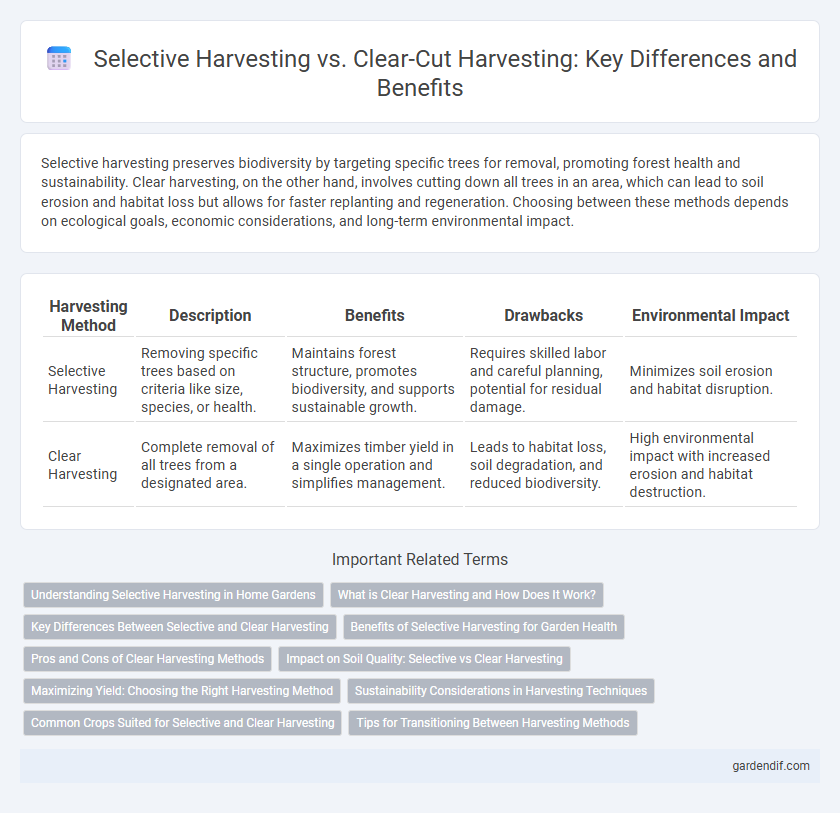
Selective Harvesting vs Clear Harvesting Illustration
Selective harvesting preserves biodiversity by targeting specific trees for removal, promoting forest health and sustainability. Clear harvesting, on the other hand, involves cutting down all trees in an area, which can lead to soil erosion and habitat loss but allows for faster replanting and regeneration. Choosing between these methods depends on ecological goals, economic considerations, and long-term environmental impact.
Table of Comparison
| Harvesting Method | Description | Benefits | Drawbacks | Environmental Impact |
|---|---|---|---|---|
| Selective Harvesting | Removing specific trees based on criteria like size, species, or health. | Maintains forest structure, promotes biodiversity, and supports sustainable growth. | Requires skilled labor and careful planning, potential for residual damage. | Minimizes soil erosion and habitat disruption. |
| Clear Harvesting | Complete removal of all trees from a designated area. | Maximizes timber yield in a single operation and simplifies management. | Leads to habitat loss, soil degradation, and reduced biodiversity. | High environmental impact with increased erosion and habitat destruction. |
Understanding Selective Harvesting in Home Gardens
Selective harvesting in home gardens involves carefully picking ripe fruits or vegetables without disturbing the entire plant, promoting continuous growth and higher yields. This method maintains plant health, reduces waste, and enhances biodiversity by allowing unripe produce to mature fully. Compared to clear harvesting, which removes all produce at once, selective harvesting supports sustainable garden management and maximizes long-term productivity.
What is Clear Harvesting and How Does It Work?
Clear harvesting, also known as clear-cutting, involves removing all trees in a designated area, creating an open space for new growth. This method promotes uniform regeneration by allowing sunlight to reach the forest floor, facilitating the growth of sun-loving species and improving timber yield. Clear harvesting is commonly used in commercial forestry to maximize economic returns and manage forest succession efficiently.
Key Differences Between Selective and Clear Harvesting
Selective harvesting targets specific mature trees for removal, preserving forest structure and promoting biodiversity, while clear harvesting involves removing all trees in an area, leading to significant habitat disruption. Selective harvesting supports continuous forest cover and soil stability by maintaining undergrowth and minimizing erosion, whereas clear harvesting exposes soil and increases the risk of erosion and nutrient loss. The key difference lies in the ecological impact and sustainability; selective harvesting fosters long-term forest health, whereas clear harvesting often prioritizes short-term economic gain at the expense of ecosystem integrity.
Benefits of Selective Harvesting for Garden Health
Selective harvesting promotes garden health by allowing sunlight to penetrate and air to circulate, which reduces fungal diseases and encourages robust plant growth. This method preserves soil structure and biodiversity by maintaining root systems and minimizing disruption to beneficial insects and microorganisms. Retaining mature plants fosters a balanced ecosystem, improving overall garden resilience and productivity.
Pros and Cons of Clear Harvesting Methods
Clear harvesting methods maximize timber yield by removing all trees in a given area, leading to faster regeneration and easier replanting. This approach can increase economic returns in the short term but often causes significant habitat disruption, soil erosion, and loss of biodiversity. Clear harvesting may also reduce long-term forest resilience compared to selective harvesting, which conserves ecosystem stability and genetic diversity.
Impact on Soil Quality: Selective vs Clear Harvesting
Selective harvesting preserves soil quality by maintaining canopy cover that reduces erosion and supports nutrient cycling, promoting long-term soil fertility. Clear harvesting exposes soil to direct sunlight and rain impact, increasing erosion risk and nutrient loss, which can degrade soil structure and reduce its productive capacity. Sustainable forestry practices favor selective harvesting for minimizing soil degradation and enhancing ecosystem resilience.
Maximizing Yield: Choosing the Right Harvesting Method
Selective harvesting improves overall forest health by removing mature or diseased trees, which promotes regeneration and sustained yield over time. Clear harvesting maximizes short-term timber volume by removing all marketable trees but can lead to soil erosion and reduced biodiversity, impacting future productivity. Choosing the right method depends on balancing immediate economic gain with long-term ecological sustainability to optimize total yield.
Sustainability Considerations in Harvesting Techniques
Selective harvesting promotes sustainability by preserving forest structure and biodiversity, allowing ecosystems to regenerate naturally and maintain carbon sequestration levels. Clear harvesting, while efficient for timber production, often leads to soil degradation, habitat loss, and reduced long-term forest productivity. Sustainable forestry practices prioritize selective harvesting techniques to balance economic needs with ecological health.
Common Crops Suited for Selective and Clear Harvesting
Selective harvesting suits crops like coffee, cocoa, and certain fruit trees, enabling gradual fruit picking that maintains plant health and supports sustainable yields. Clear harvesting is commonly applied to grains such as wheat, rice, and corn, facilitating efficient, large-scale removal of mature crops in a single operation. Understanding crop type and growth patterns is essential for choosing between selective and clear harvesting methods to optimize yield and resource management.
Tips for Transitioning Between Harvesting Methods
Transitioning between selective harvesting and clear harvesting requires strategic planning to maintain forest health and productivity. Prioritize assessing stand conditions and growth patterns to determine the appropriate timing for method shifts, ensuring minimal ecological disruption. Employ adaptive management techniques and monitor regeneration closely to optimize long-term sustainability during the transition phase.
Selective Harvesting vs Clear Harvesting Infographic

 gardendif.com
gardendif.com